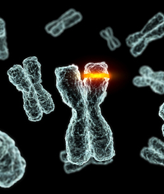Dual HER2 Targeting Benefits Subset of Breast Cancer Patients
A follow-up analysis of gene expression signatures from the CALGB 40601 trial shows that certain HER2-positive early-stage breast cancer patients may not benefit from more aggressive chemotherapy treatments as part of a neoadjuvant regimen, and that patients with HER2-enriched tumors responded best to dual anti-HER2 treatment.

A follow-up analysis of gene expression signatures from the Cancer and Leukemia Group B (CALGB) 40601 neoadjuvant phase III clinical trial shows that certain HER2-positive early-stage breast cancer patients may not benefit from more aggressive chemotherapy treatments as part of a neoadjuvant regimen. The study further confirms that HER2-positive breast cancer is a molecularly disparate disease, not unlike triple-negative disease.
Lisa Carey, MD, professor in breast cancer research at the University of North Carolina at Chapel Hill and medical director of the UNC Breast Center, presented the data (abstract 506) at the 2014 American Society of Clinical Oncology (ASCO) Annual Meeting, held May 30–June 3 in Chicago. The efficacy results from the trial, presented at the 2013 meeting, showed that combining two HER2-targeted agents-trastuzumab and lapatinib-in the neoadjuvant setting was not more effective in yielding pathologic complete responses (pCRs), as compared with trastuzumab alone. A total of 305 stage II and III HER2-positive patients were randomized to receive 16 weeks of paclitaxel plus trastuzumab, paclitaxel plus lapatinib, or the combination of all three. The paclitaxel plus lapatinib arm was discontinued early due to lack of efficacy.
There was a numerical difference in pCR rates between the two groups (56% for the three-drug combination compared with 46% for the paclitaxel plus trastuzumab combination), but the difference was not statistically significant. The study did show, however, that patients with HER2-enriched tumors had higher pCR rates.
The new “gene expression analysis confirms that HER2-positive disease is highly heterogeneous, and that there is a significant difference in response between molecular subtypes, regardless of what regimen is used,” Carey told Cancer Network.
mRNA sequencing was performed on 271 pre-treatment and 136 post-treatment tumor samples. Thirty percent were luminal A, 31% were luminal B, 31% were HER2-enriched, and 5% were basal-like. Sixty percent of the pre-treatment samples were hormone receptor–positive. Post-therapy, there was a switch in subtype-43% were luminal A, 3% were luminal B, 5% were HER2-enriched, and 2% were basal-like. The most frequent switch in subtypes was to the luminal A subtype, which occurred in 67% of HER2-enriched and 70% of luminal B tumors. “Whether these differences and specifically the elevated likelihood of luminal A biology is due to stromal alteration or tumor reprogramming remains to be seen,” said Carey.
According to Carey, this analysis was done to “identify the nature of residual disease, which may be relevant for identifying appropriate combination strategies and mechanisms to avoid resistance.”
The in-breast pCR rate was 46%, with the majority of responses (69%) in patients with HER2-enriched tumors (P < .0001). Within these HER2-enriched tumors, the greatest response rate (80%) was in the triple therapy arm, compared with 71% in the paclitaxel plus trastuzumab arm and 50% in the paclitaxel plus lapatinib arm.
The motivation for this analysis was the increasing recognition that even clinical subtypes of breast cancer have substantial variability in biology, which may dictate response to therapy, and particularly, that response to chemotherapy can vary depending on the subtype of disease.
Additionally, patients who had a pCR were more likely to have a high expression of immune signatures, although the exact role of specific immune responses is not clear.
While these results will not change treatment decisions as of yet, “if confirmed through pooled analyses of other similar trials, [clinicians may be able to] identify patients with a very high likelihood of response to relatively simple regimens,” said Carey. “Alternatively, we may be able to identify those patients for whom additional treatment is necessary.”
References:
1. Carey L, Barry WT, Pitcher B, et al. Gene expression signatures in pre- and post-therapy (Rx) specimens from CALGB 40601 (Alliance), a neoadjuvant phase III trial of weekly paclitaxel and trastuzumab with or without lapatinib for HER2-positive breast cancer (BrCa). Presented at the 2014 American Society of Clinical Oncology (ASCO) Annual Meeting; Abstract 506.